The Crab Nebula, also known as Messier 1 and Taurus A, is a supernova remnant located in the direction of Taurus constellation.
The nebula lies at an approximate distance of 6,500 light years from Earth. It is an expanding remnant of a star that met its end as a supernova that was observed by Chinese astronomers in the year 1054 AD. The nebula’s designation in the New General Catalogue is NGC 1952.
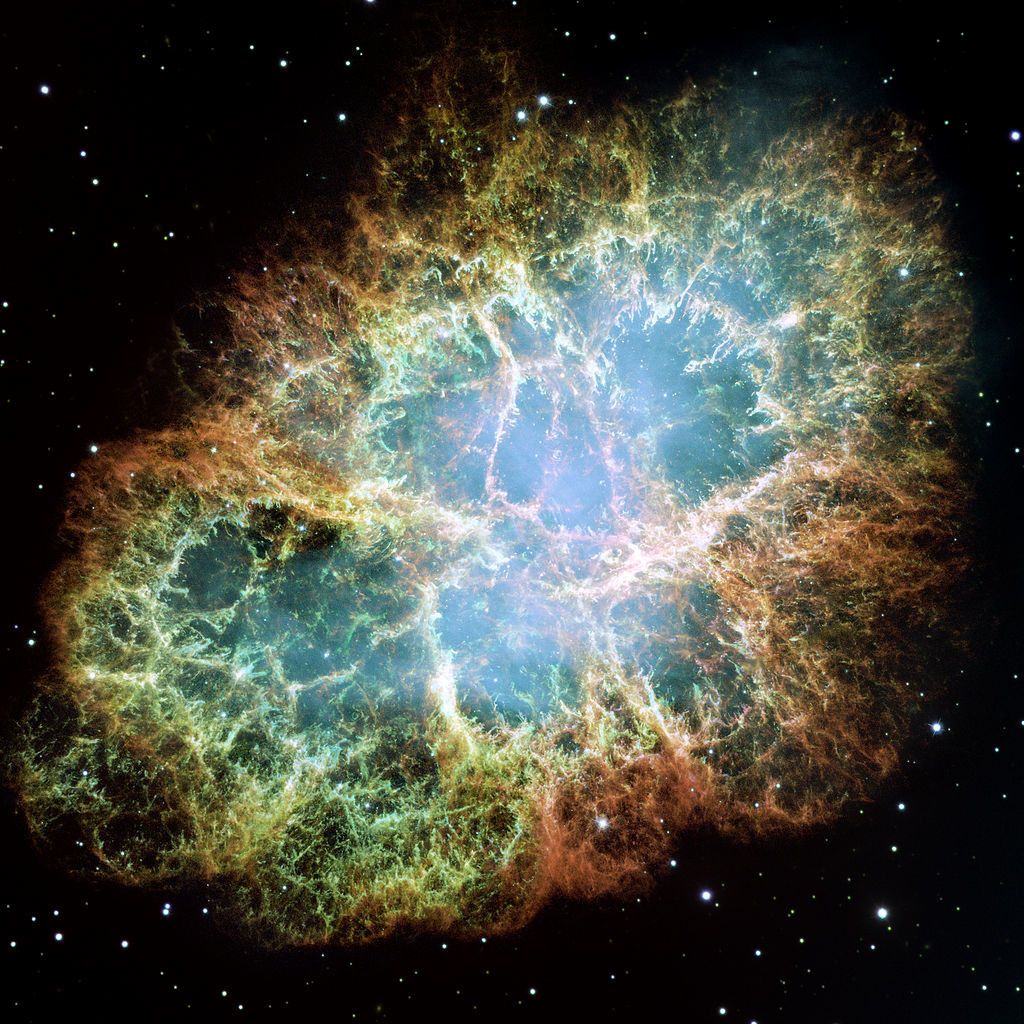
This is a mosaic image, one of the largest ever taken by NASA’s Hubble Space Telescope of the Crab Nebula, a six-light-year-wide expanding remnant of a star’s supernova event. Japanese and Chinese astronomers recorded this event nearly 1,000 years ago in 1054, as did, almost certainly, Native Americans. The orange filaments are the tattered remains of the star and consist mostly of hydrogen. The rapidly spinning neutron star embedded in the center of the nebula is the dynamo powering the nebula’s eerie interior bluish glow. The blue light comes from electrons whirling at nearly the speed of light around magnetic field lines from the neutron star. The neutron star, like a lighthouse, ejects twin beams of radiation that appear to pulse 30 times a second due to the neutron star’s rotation. A neutron star is the crushed ultra-dense core of the remnant star. The Crab Nebula derived its name from its appearance in a drawing made by Irish astronomer Lord Rosse in 1844, using a 36-inch telescope. When viewed by Hubble, as well as by large ground-based telescopes such as the European Southern Observatory’s Very Large Telescope, the Crab Nebula takes on a more detailed appearance that yields clues into the spectacular demise of a star, 6,500 light-years away. The newly composed image was assembled from 24 individual Wide Field and Planetary Camera 2 exposures taken in October 1999, January 2000, and December 2000. The colors in the image indicate the different elements that were expelled during the supernova. Blue in the filaments in the outer part of the nebula represents neutral oxygen, green is singly-ionized sulfur, and red indicates doubly-ionized oxygen. Image: NASA, ESA, J. Hester and A. Loll (Arizona State University)
The Crab Nebula was created as a result of an exceptionally bright supernova event, one that was visible to the unaided eye for almost two years. The supernova remnant was later observed by the English astronomer John Bevis, who discovered it in 1731.
Charles Messier discovered the object independently in 1758 while looking for a comet that Edmond Halley said would return that year.
Messier 1 is also classified as a pulsar wind nebula, which means that the nebula is made of the material ejected by a pulsating neutron star interacting with interstellar gas and the magnetic field of the pulsar itself.
The Crab Nebula expands at a rate of 1,500 kilometres per second. It contains two dim stars at its centre, one of which is the neutron star.
The nebula is notable for its intricate structure, with filaments of dust that can be seen in visible wavelengths. Its contains enough dust, made of carbon and silicate materials, to make 30,000-40,000 Earths.
Study of the nebula provided definitive proof that supernova events created the raw materials for the first solid particles.
Messier 1 is the strongest known persistent source of X-ray and gamma-ray radiation in the sky. It contains the Crab Pulsar at its centre, a neutron star about 28-30 kilometres across. The star’s core emits pulses of radiation from gamma rays to radio waves as it spins at a rate of 30.2 per second.
This is useful for studying the objects that pass in front of the nebula, blocking its radiation, like the Sun or the moons orbiting the planets in the solar system. In 2003, scientists used it to measure the thickness of Titan’s (Saturn’s moon) atmosphere and in the mid-20th century, they used it to map the Sun’s corona.
The Crab Nebula has an apparent magnitude of 8.4 and cannot be seen without binoculars or a telescope. Observing it with binoculars requires good viewing conditions, and it only appears as a faint patch of light in 7×50 and 10×50 binoculars.
In 4-inch telescopes, one can see a hint of the nebula’s streak structure in the central region, and in most smaller telescopes the nebula looks similar to a comet without a tail. The filaments and details of the nebula’s structure are only visible in 16-inch or larger telescopes in good viewing conditions.
The Crab Nebula occasionally flares up. The most recent flare was recorded in March 2013, when the nebula exhibited a spike in gamma-ray emission three times more intense than its usual output. In April 2011, a particularly bright outburst was recorded that made the nebula about 30 times brighter than it normally is. The flares are suspected to be the result of the pulsar’s wind.
FACTS
M1 is about 11 light years in diameter, which translates into 7 arc minutes of apparent diameter. It is part of the Perseus Arm of our galaxy, the Milky Way.
The Crab Nebula was the first object to be entered in Messier’s catalogue and remains one of the most studied objects in the night sky. It helps that the view of the nebula is not obscured by dust and other interstellar material, which makes it easy to observe and study.
The nebula was also the first object associated with a historical supernova event.
The supernova remnant was discovered by John Bevis in 1731, who included it in his sky atlas, Uranographia Britannica. Charles Messier observed the object independently on August 28, 1758, and thought it was a comet. Once he had realized that the object did not have apparent proper motion, he entered it into his catalogue on September 12, 1758. Messier’s catalogue was created to list objects that sky watchers confused for comets, and the Crab Nebula was the first deep sky object on his list.
The supernova event in 1054 was so bright that it was visible in the daytime sky for 23 days. The event was documented by astronomers and sky watchers throughout the Far East.
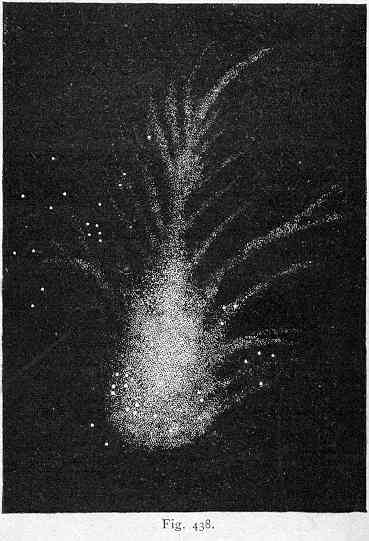
Drawing of the Crab Nebula. Originally published in Observations on Some of the Nebulae, Philosophical Transactions of the Royal Society of London vol. 134 (1844). Author: William Parsons, 3rd Earl of Rosse.
British astronomer William Parsons, Lord Rosse, sketched the nebula around 1844 after observing it though a 36-inch telescope. The image of the object resembled a crab, which is how the nebula got its name. The name stuck even though Lord Rosse later said his sketch was not representative of the nebula’s appearance and structure after observing it through a 72-inch telescope in 1848.
The nebula was first photographed n 1892 using a 20-inch telescope.
It wasn’t until the early 20th century that scientists determined that the nebula was expanding and matched its origination date to the historical supernova.
In 1918, the American astronomer Heber D. Curtis classified the object as a planetary nebula. It was not until 1933 that this classification was disproved. In 1921, the American astronomer Carl Otto Lampland used photographs of the nebula taken using a 42-inch reflector and discovered motions inside the nebula. He saw that individual components changed in brightness, especially those in the vicinity of the central pair of stars.
1921 was also the year the American astronomer John Charles Duncan discovered that the nebula was expanding at a rate of about 0.2” per year after comparing photographs taken 11.5 years apart. It was the Swedish astronomer Knut Lundmark who first noted the proximity of the Crab Nebula to the historical supernova of 1054, also in 1921. In 1928, the American astronomer Edwin Hubble suggested that the object be associated with the historical supernova.
In 1942, the German astronomer Walter Baade used a 100-inch Hooker telescope to study the nebula and traced back its year of origin to 1180. Later calculations changed the estimated date to 1140. As the supernova occurred in 1054, the expansion rate of the nebula is believed to have accelerated. The nebula was linked to the Supernova 1054 beyond reasonable doubt in 1942 by the Dutch astronomer Jan Oort.
Crab Nebula – Messier 1 (NGC 1952, Sharpless 244)
Coordinates: 05h34m31.94s (right ascension), +22°00’52.2” (declination)
Visual magnitude: 8.4
Absolute magnitude: -3.1
Distance: 6,500 light years
Apparent dimensions: 420” x 290”
Radius: 5.5 light years
Constellation: Taurus
PULSAR
The pulsar inside the Crab Nebula is the rapidly spinning, relatively young neutron star that powers the nebula. A neutron star is created in the aftermath of a supernova. Stars meet their ends as supernovae when they run out of fuel to keep from collapsing into themselves; their outer layers are ejected into space, creating a nebula, while the inner cores contract to form neutron stars.
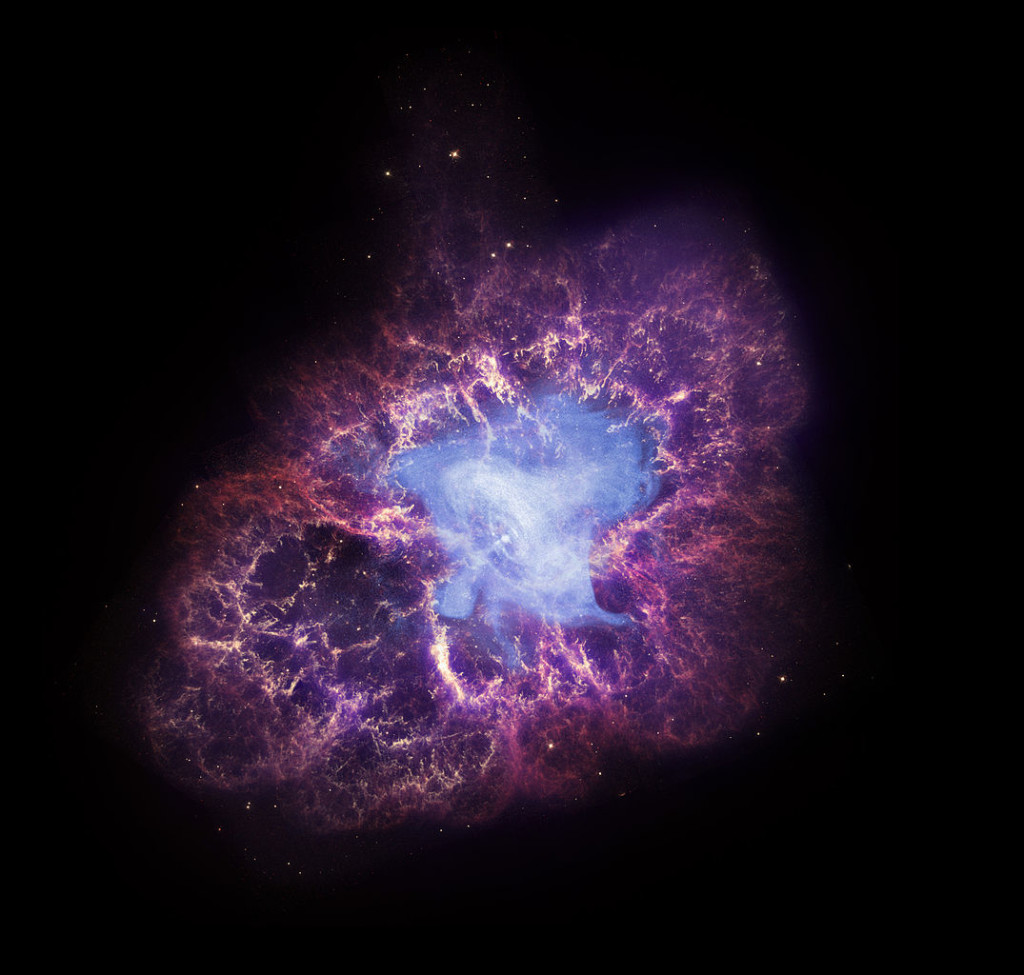
A star’s spectacular final stage in the constellation Taurus was observed on Earth as the supernova of 1054 A.D. Now, almost a thousand years later, a super dense object — called a neutron star — left behind by the supernova is seen spewing out a blizzard of high-energy particles into the expanding debris field known as the Crab Nebula. X-ray data from Chandra provide significant clues to the workings of this mighty cosmic “generator,” which is producing energy at the rate of 100,000 suns. This composite image uses data from three of NASA’s Great Observatories. The Chandra X-ray image is shown in blue, the Hubble Space Telescope optical image is in red and yellow, and the Spitzer Space Telescope’s infrared image is in purple. The X-ray image is smaller than the others because exceptionally energetic electrons emitting X-rays radiate away their energy more quickly than the lower-energy electrons emitting optical and infrared light. Along with many other telescopes, Chandra has repeatedly observed the Crab Nebula over the course of the mission’s lifetime. The Crab Nebula is one of the most studied objects in the sky, truly making it a cosmic icon. Image – X-Ray: NASA/CXC/J.Hester (ASU); Optical: NASA/ESA/J.Hester & A.Loll (ASU); Infrared: NASA, JPL-Caltech, R.Gehrz (Univ. Minn.)
The neutron star that remains is very small, normally just 10 to 15 miles across, but it is very dense. The star within the Crab Nebula rotates very rapidly, and completes about 30 revolutions each second. Rotating neutron stars like this one are called pulsars. The word is derived from the contraction of the term “pulsating star.”
The Crab Pulsar is one of the most powerful pulsars known. It lights the nebula in every wavelength, from radio to gamma-rays. The optical pulsar has a diameter of about 20 kilometres.
The X-rays emitted by the nebula were discovered in April 1963, and the source was subsequently named Taurus X-1. After further observation, scientists concluded that the X-rays come from an area which is at least 2 arcminutes in size, and that the nebula’s X-ray emission is roughly 100 times more intense that the energy emitted in visible light. The nebula’s luminosity in visible light translates into an absolute magnitude of about -3.2, which makes the Crab Nebula more than 1,000 times more luminous than the Sun. Its luminosity across all spectral ranges is estimated to be 100,000 times that of the Sun.
The Italian astrophysicist Franco Pacini predicted the existence of a neutron star in the 1960s to account for the nebula’s brightness.
The Crab Pulsar (PSR B0531+21) was discovered in Messier 1 on November 9, 1968. The pulsating radio source was detected at the Arecibo Observatory in Puerto Rico by astronomers using a 300-meter radio telescope.
On January 15, 1969, astronomers at the Steward Observatory in Tucson, Arizona, observed the nebula using a 36-inch telescope and discovered that the Crab Pulsar was flashing with a period of 33.085 miliseconds. The knowledge of the pulsar’s exact age helped astronomers in the study of these objects and their physical properties. The only other pulsar connected to a known supernova is located in 3C58 in Cassiopeia constellation, the remnant of the supernova SN 1181, but the connection between the two has been contested. The discovery of the pulsar within the Crab Nebula confirmed the theory that neutron stars were formed in certain types of supernova events.
The pulsar was really first detected in the summer of 1967 by Charles Schisler, a U.S. Air Force officer, who detected a radio source and determined its position, which corresponded to that of the Crab Nebula. Schisler later discovered a number of other pulsars, but the Air Force never published his discoveries because they did not think they were of any concern to them.
The Crab Pulsar emits pulses in every part of the electromagnetic spectrum and powers the nebula. Its spin rate, 30 times per second, is slowly decelerating, by 38 nanoseconds per day, because the pulsar wind carries away a lot of its energy. The spinning neutron star has a visual magnitude of 16 in visible light and an absolute magnitude of 4.5, roughly the same as the Sun in visible light.
SUPERNOVA
SN 1054, the supernova that created the Crab Nebula was originally seen by Chinese astronomers on July 4, 1054 AD. They documented it as a “guest star,” a new star in the sky that appeared four times brighter than the planet Venus.
At its peak, the supernova had a visual magnitude of about -6, and could be seen during the day for 23 days. The event was visible to the unaided eye for 653 days at night. It was the brightest object in the sky next to the Moon for a few months, and is the best known supernova in the history of astronomy. Supernova 1054 was given the variable star designation CM Tauri.
The star that went supernova was 12 to 15 times more massive than the Sun and was turned into a small neutron star that spins rapidly, ejecting stellar material.
LOCATION
The Crab Nebula is located near the southern horn of the celestial bull, represented by Taurus constellation. The southern horn is marked by the 3rd magnitude star Zeta Tauri, located to the east-northeast of the bright Aldebaran, Alpha Tauri. The nebula can be found approximately 1 degree to the north and 1 degree to the west of Zeta Tauri. It is best seen in the evenings in January.
Messier 1 lies only a degree and a half from the ecliptic and is frequently eclipsed by planets and the Moon.
IMAGES
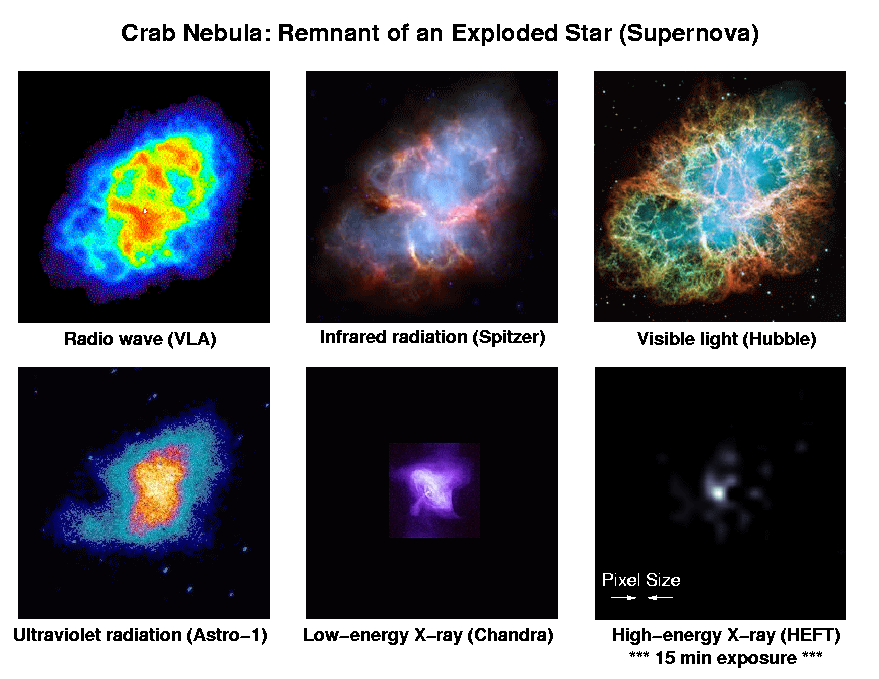
Messier 1 (Crab Nebula) photographed by High Energy Focusing Telescope (HEFT), NASA’s Scientific Ballooning Program. Image: CM Hubert Chen, Fiona A. Harrison, Principal Investigator, Caltech Charles J. Hailey, Columbia Principal, Columbia, Finn E. Christensen, DSRI Principal, DSRI, William W. Craig, Optics Scientist, LLNL, Stephen M. Schindler, Project Manager, Caltech
Composite:
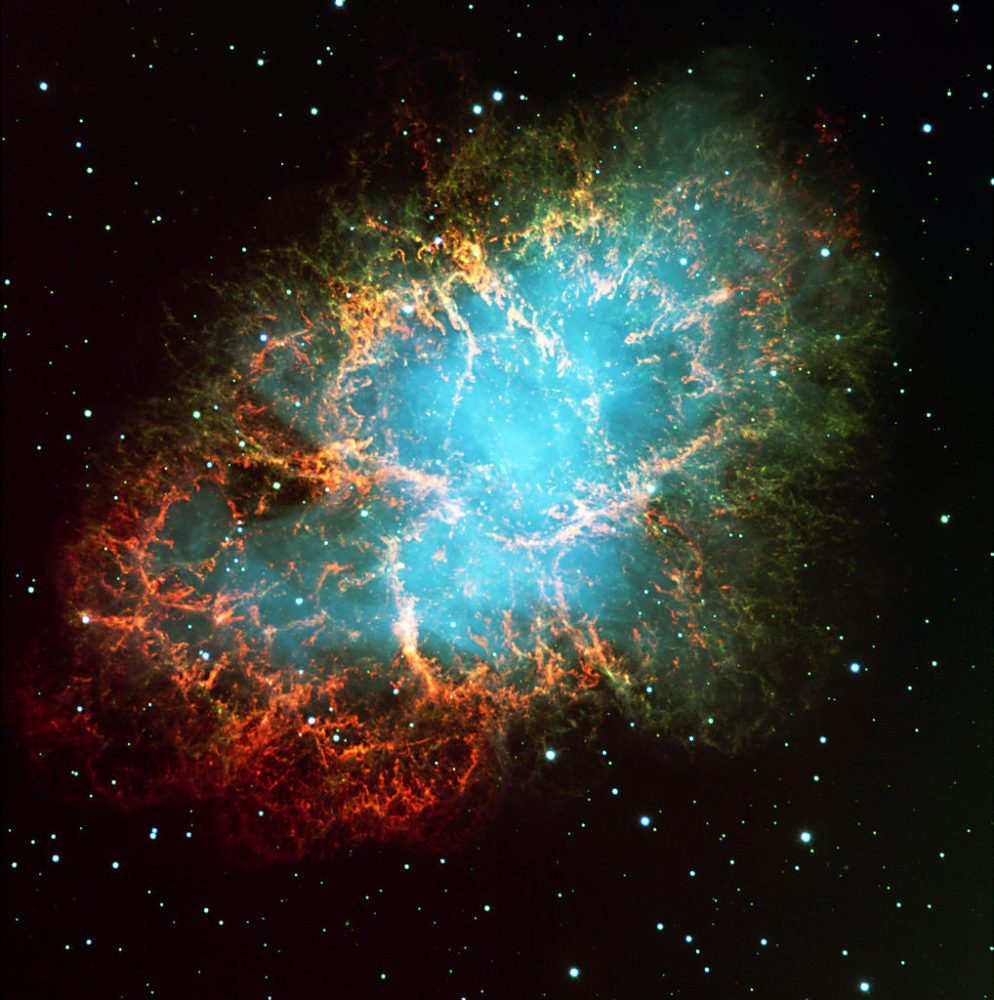
This photo shows a three colour composite of the well-known Crab Nebula (also known as Messier 1), as observed with the FORS2 instrument in imaging mode in the morning of November 10, 1999. It is the remnant of a supernova event at a distance of about 6,000 light-years, observed almost 1,000 years ago, in the year 1054. It contains a neutron star near its center that spins 30 times per second around its axis (see below). In this picture, the green light is predominantly produced by hydrogen emission from material ejected by the star that went supernova. The blue light is predominantly emitted by very high-energy (“relativistic”) electrons that spiral in a large-scale magnetic field (so-called syncrotron emission). It is believed that these electrons are continuously accelerated and ejected by the rapidly spinning neutron star at the centre of the nebula and which is the remnant core of the star. This pulsar has been identified with the lower/right of the two close stars near the geometric center of the nebula, immediately left of the small arc-like feature, best seen in ESO Press Photo eso9948 .Technical information : ESO Press Photo eso9948 is based on a composite of three images taken through three different optical filters: B (429 nm; FWHM 88 nm; 5 min; here rendered as blue), R (657 nm; FWHM 150 nm; 1 min; green) and S II (673 nm; FWHM 6 nm; 5 min; red) during periods of 0.65 arcsec (R, S II) and 0.80 (B) seeing, respectively. The field shown measures 6.8 x 6.8 arcmin and the images were recorded in frames of 2048 x 2048 pixels, each measuring 0.2 arcsec. North is up; East is left. Image: ESO
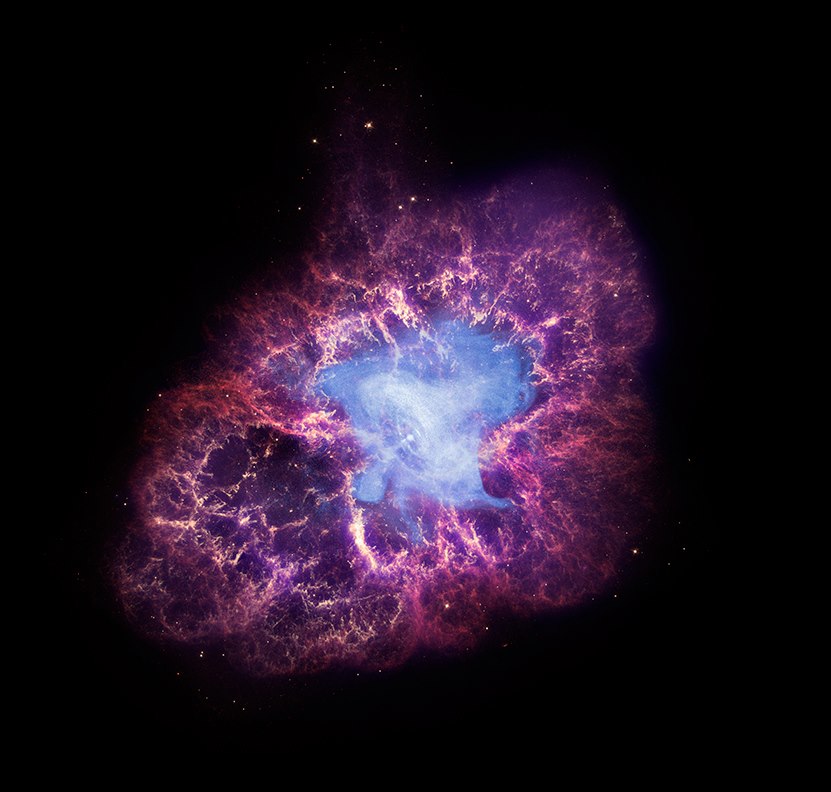
This image of the Crab combines data from three of NASA’s Great Observatories. X-rays from Chandra (blue) have been combined with optical images from Hubble (red and yellow) as well as infrared data from Spitzer (purple). Together, these three telescopes provide a striking view of this famous cosmic source. Image: Joseph DePasquale, Chandra X-Ray Observatory
Visible light:
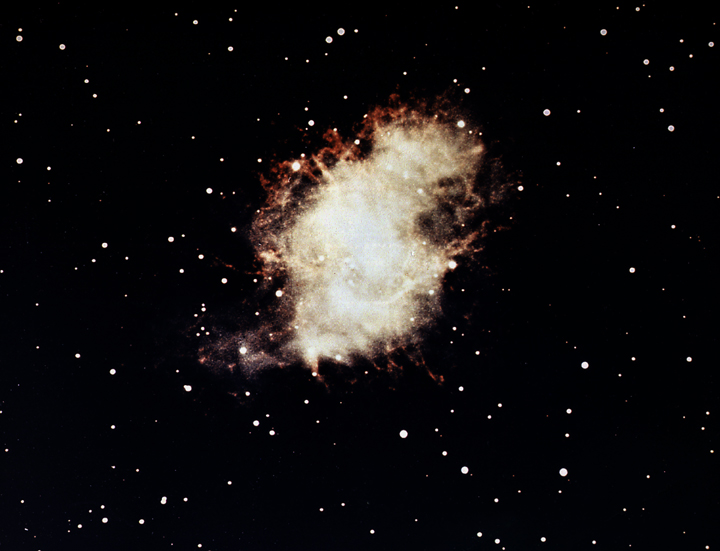
Crab Nebula in visible light taken by the Hale Observatory optical telescope in 1959. Image: NASA Marshall Space Flight Center (NASA-MSFC)
X-ray:
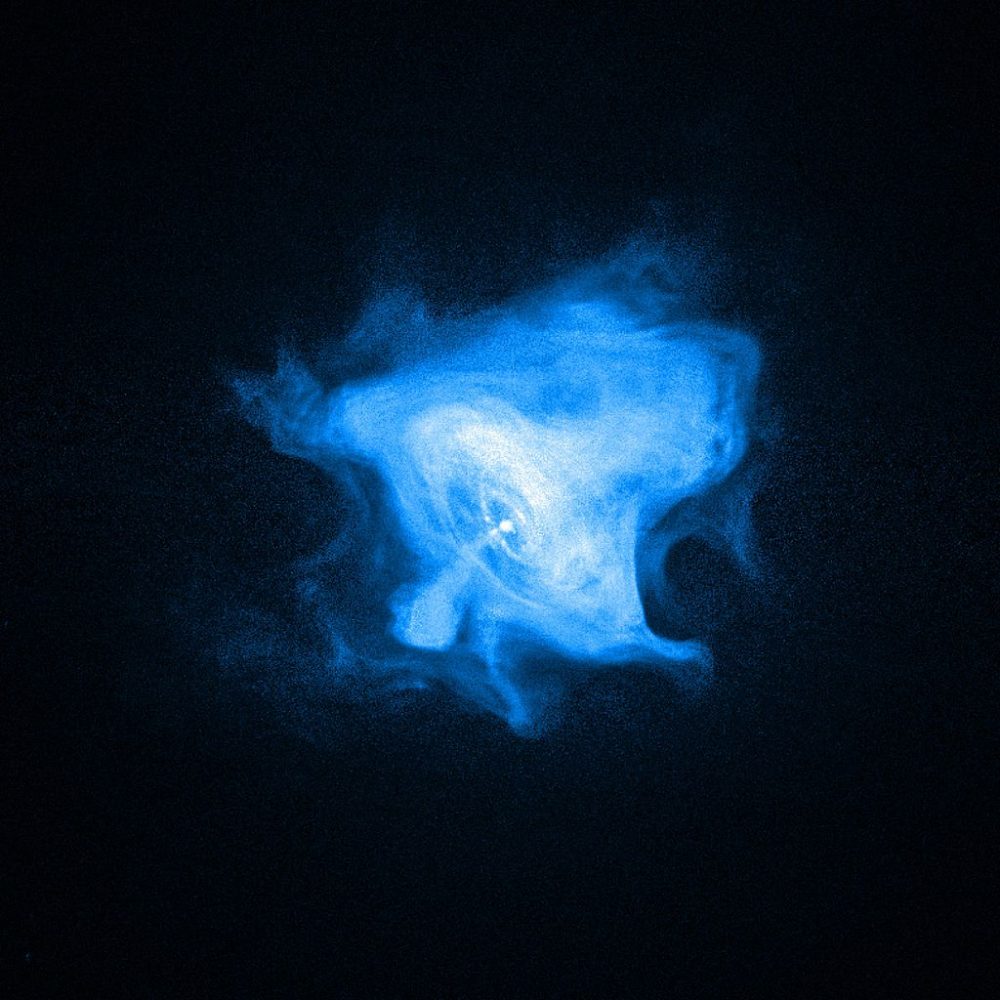
In the Crab Nebula, a rapidly rotating neutron star, or pulsar (white dot near the center), powers the dramatic activity seen by Chandra. The inner X-ray ring is thought to be a shock wave that marks the boundary between the surrounding nebula and the flow of matter and antimatter particles from the pulsar. Energetic particles move outward to brighten the outer ring and produce an extended X-ray glow. The jets perpendicular to the ring are due to matter and antimatter particles spewing out from the poles of the pulsar. The fingers, loops and bays visible on the outer boundary of the nebula are likely caused by confinement of the high-energy particles by magnetic forces.
Creator/Photographer: Chandra X-ray Observatory
The Chandra X-ray Observatory, which was launched and deployed by Space Shuttle Columbia on July 23, 1999, is the most sophisticated X-ray observatory built to date. The mirrors on Chandra are the largest, most precisely shaped and aligned, and smoothest mirrors ever constructed. Chandra is helping scientists better understand the hot, turbulent regions of space and answer fundamental questions about origin, evolution, and destiny of the Universe. The images Chandra makes are twenty-five times sharper than the best previous X-ray telescope. The Smithsonian Astrophysical Observatory controls Chandra science and flight operations from the Chandra X-ray Center in Cambridge, Massachusetts.
Medium: Chandra telescope X-ray
Date: 2008
Image: NASA, CXC, SAO, F.Seward et al.
Infrared:
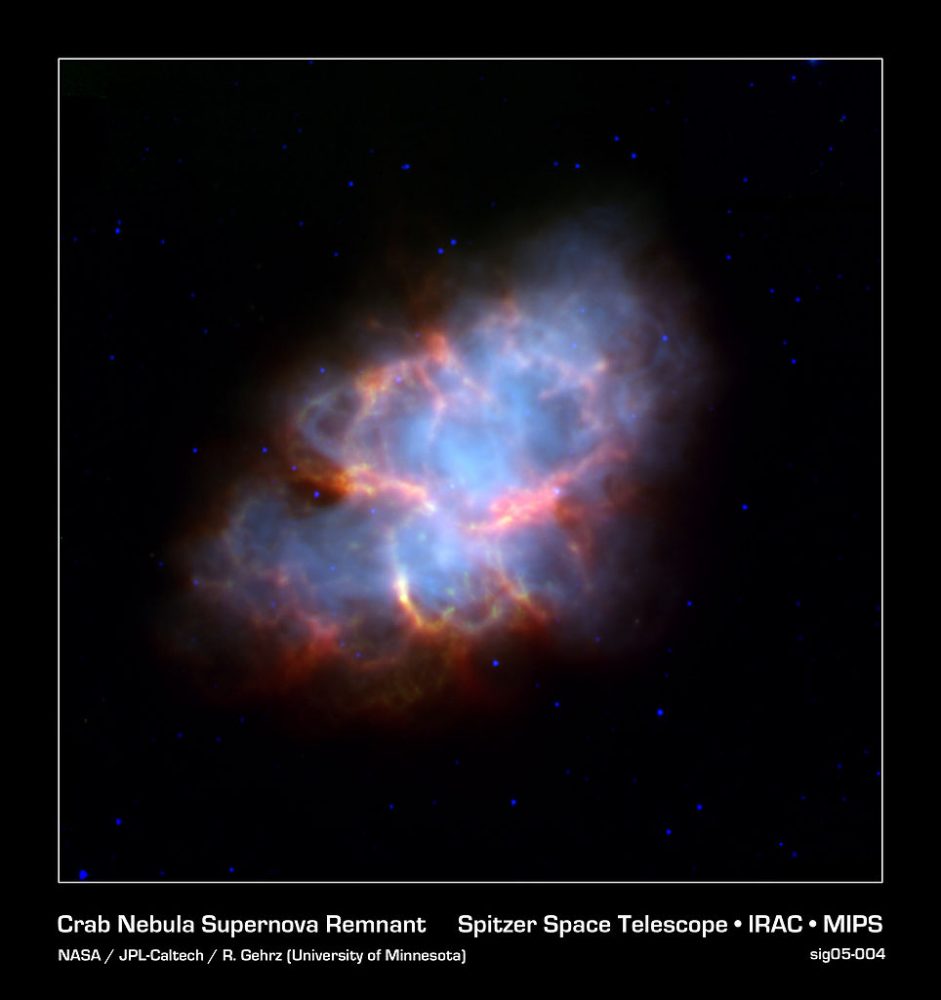
The Crab Nebula is the shattered remnant of a massive star that ended its life in a massive supernova. Nearly a thousand years old, the supernova was noted in the constellation of Taurus by Chinese astronomers in the year 1054 AD. This view of the supernova remnant obtained by the Spitzer Space Telescope shows the infrared view of this complex object. The blue region traces the cloud of energetic electrons trapped within the star’s magnetic field, emitting so-called “synchrotron” radiation. The yellow-red features follow the well-known filamentary structures that permeate this nebula. Though they are known to contain hot gasses, their exact nature is still a mystery that astronomers are examining. The energetic cloud of electrons are driven by a rapidly rotating neutron star, or pulsar, at its core. The nebula is about 6,500 light-years away from the Earth, and is 5 light-years across. This false-color image presents images from Spitzer’s Infrared Array Camera (IRAC) and Multiband Imaging Photometer (MIPS) at 3.6 (blue), 8.0 (green), 24 (red) microns. Image: NASA, JPL-Caltech, R. Gehrz (University of Minnesota)